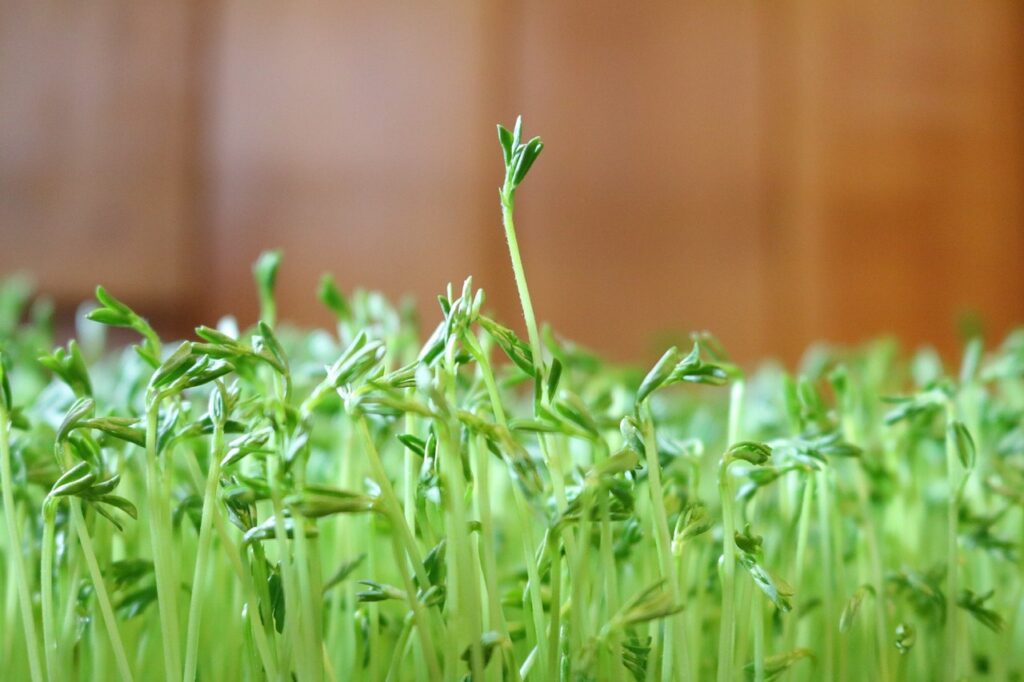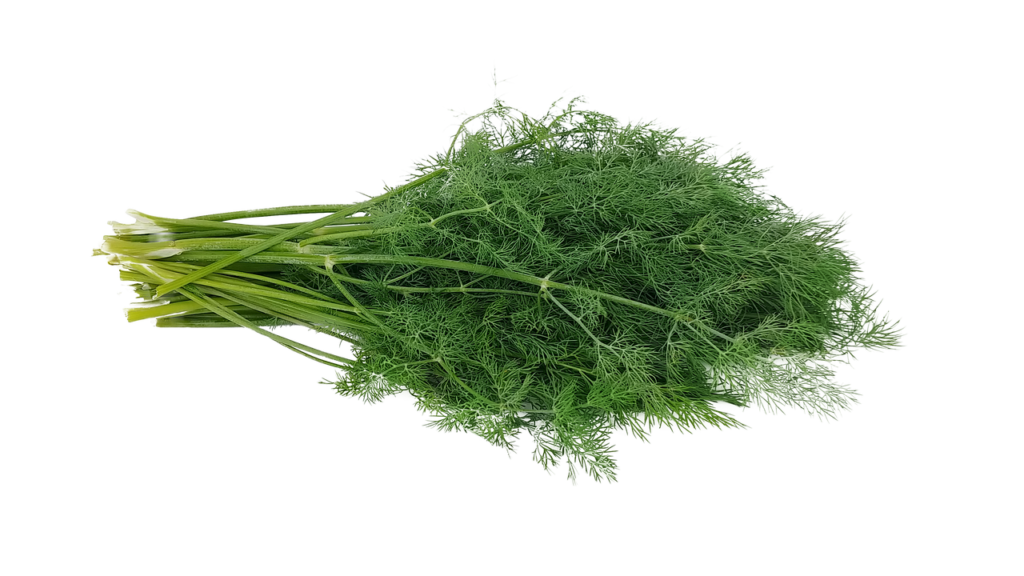Growing Microgreens has become a worldwide trend. Lentil microgreens(micros in general too) have seen an exponential increase in popularity from health enthusiasts for their high nutrient content, ease of cultivation, and delicious taste. They are packed with protein, fiber, vitamins, and minerals, making them an ideal addition to any diet.
In this blog post, we will discuss the best practices for growing them, including sowing, lighting, watering, and ideal conditions. We will also explore the nutritional elements and answer some frequently asked questions.
As an Amazon and ebay Affiliate we may earn a commission off any purchases made through our links. This won’t affect the price you pay.
Sowing Lentil Microgreens Seeds
Sowing lentils microgreens seeds is an easy and straightforward process. First, you need to select a suitable growing medium like soil or coconut coir. You can use a tray or a container to grow your microgreens.
Sow the seeds at a depth of 1/8 to 1/4 inch, and make sure to space them evenly to prevent overcrowding. Cover the seeds with soil or coir and spray with water.

The seeds sprout within a week, and the microgreens are ready to harvest in 7 to 14 days. You can either harvest them all at once or gradually over a few days.
Best Lights for Growing Lentil Microgreens
Growing lentil microgreens requires proper lighting, as they need bright and consistent light to grow well. A lack of light can result in slow growth, stretched seedlings, and low yield. Therefore, it’s essential to choose the right lights for your lentil microgreens.
The best lights for growing lentil microgreens are LED grow lights. LED lights are affordable, energy-efficient, and produce the full-spectrum light that mimics natural sunlight. They are also adjustable, allowing you to manipulate the light intensity and wavelength to suit your plants’ specific needs.
LED grow lights are available in various sizes, shapes, and colors. They come in different wattages, ranging from 45W to 1000W, allowing you to choose the optimal wattage for your growing space.
When choosing LED grow lights for your lentil microgreens, consider the color spectrum. Blue light is ideal for vegetative growth, while red light is suitable for flowering and fruiting. A balanced spectrum with a combination of blue and red light is best for overall plant growth and health.
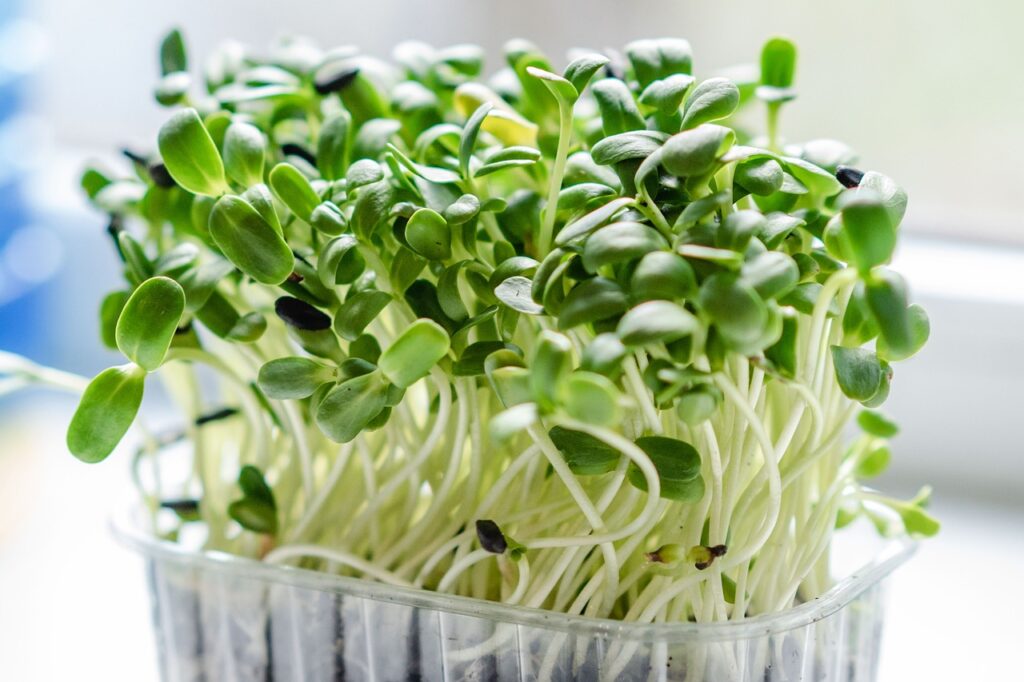
The distance between the LED grow light and the lentil microgreens is also crucial. Too much light may cause heat stress and damage the plants, while too little light may lead to leggy and weak seedlings. The ideal distance is between 6 to 12 inches from the seedlings, depending on the wattage of the LED light and the growth stage of the plants.
In addition to LED grow lights, you can also use fluorescent or incandescent bulbs. However, these lights are not as efficient as LED lights and may produce heat, which can harm the plants.
Best Watering Practice for Lentil Microgreens
Watering lentil microgreens is a critical aspect of their growth cycle. Overwatering or underwatering can lead to stunted growth, mold growth, or wilting. Adopting the right technique will enable you to keep your lentil microgreens healthy and thriving.
One of the best ways to water lentil microgreens is bottom watering. This method involves placing the tray with the microgreens on a larger tray filled with water. It allows the plants to absorb water from the bottom of the tray, which helps prevent mold growth and waterlogged soil. Bottom watering also encourages root growth and provides the plants with essential nutrients through capillary action.
Another effective method is misting. This method involves using a spray bottle to mist the microgreens gently. This method is suitable for small quantities of microgreens and encourages proper hydration and nutrient uptake.
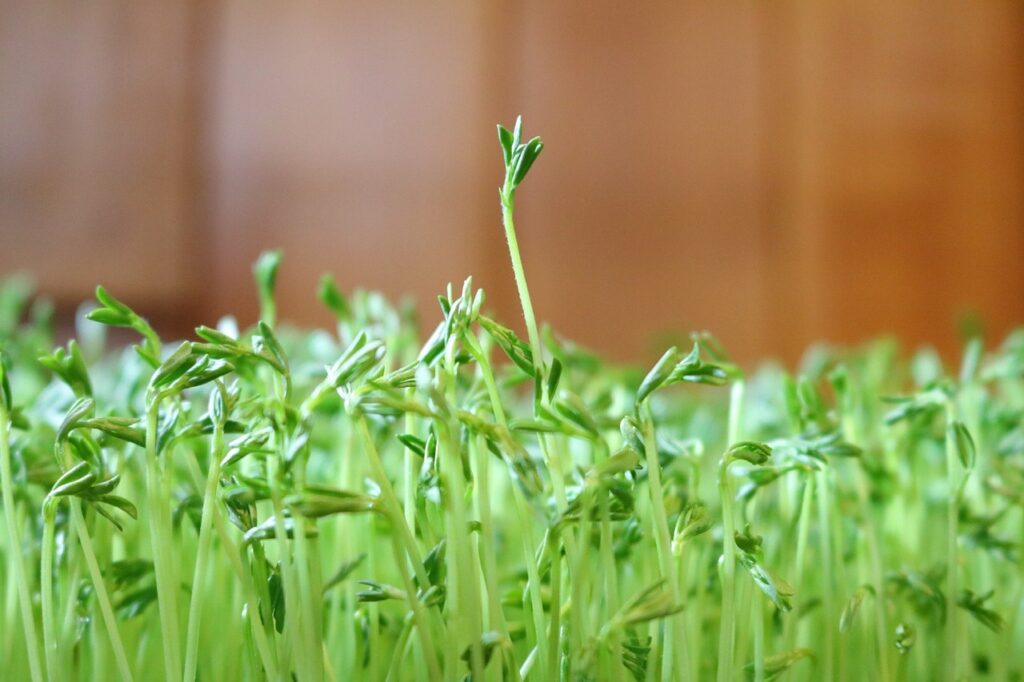
Drip irrigation systems are another option for watering lentil microgreens. These systems use a timed release of water, providing a regulated flow of water to the plants. Drip irrigation systems also reduce water waste and prevent damage to the plants caused by overwatering and waterlogged soil.
Automated watering systems are ideal for growers who are short on time or have multiple trays of microgreens. These systems can be set to water the lentil microgreens at specific intervals and for a duration suitable for the plant’s growing stage. They also reduce the risk of human error in watering and lead to increased yields.
When using automated watering systems, it’s essential to balance the water amount and frequency. Overwatering can cause mold growth, while underwatering can dry out the plants and reduce growth. It’s important to monitor and test your automated system regularly to ensure the optimal hydration of your lentil microgreens.
Ideal Conditions for Growing
Growing lentil microgreens requires specific conditions to thrive. The ideal conditions include temperature, humidity, light, and watering. Maintaining optimal growing conditions will ensure healthy and robust lentil microgreens.
Humidity is a crucial factor in growing lentil microgreens. The ideal humidity range for them is between 60% to 70%. If the air is too dry, the plants may wilt and die. On the contrary, high humidity increases the risk of mold and fungal growth, which can damage the plants. A good solution to maintain proper humidity levels is a humidifier. A humidifier can add moisture to the air and create a stable environment for the plants to grow.

Temperature is another significant factor in growing lentil microgreens. They prefer temperatures between 70 to 75°F. The temperature is essential for determining the growth rate and production of the microgreens. Maintaining a stable temperature is essential for healthy plant growth. Sudden temperature changes may stress the plants and result in poor growth. It is recommended to keep the microgreens away from heat sources like radiators or vents, as they can dry out the plants and influence the temperature.
As previously mentioned, light is also a critical factor in growing lentil microgreens. To reiterate, lentil microgreens need light – bright, full-spectrum light for photosynthesis and healthy growth. LED grow lights are an ideal option for growing lentil microgreens indoors. The light should also be placed at an optimal distance from the plants to avoid burning and stretching. The ideal distance from the light source is between 6 to 12 inches.
Nutritional Elements
Lentil microgreens are a rich source of essential nutrients that are beneficial to overall health and wellbeing. They are a powerhouse of protein, vitamins, minerals, and antioxidants, making them a nutrient-dense food choice.
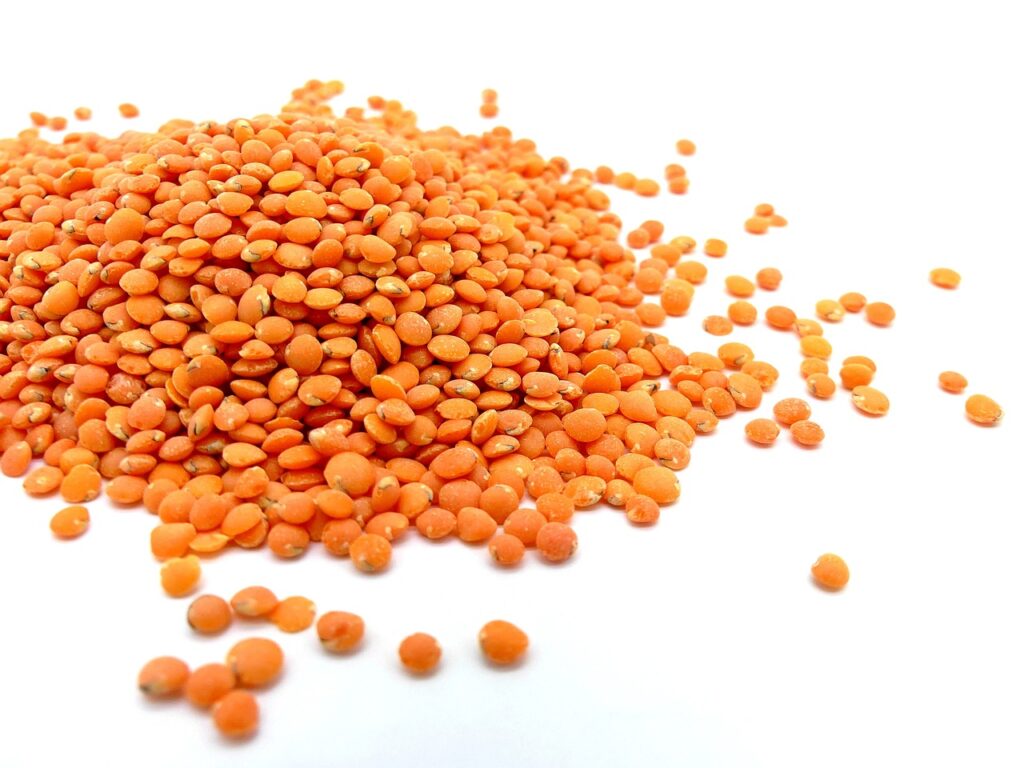
Lentil microgreens are an excellent source of protein, especially for vegetarians and vegans who may struggle to meet their daily protein requirements. They contain up to 35 percent protein, which is higher than most vegetables and fruits. Protein is essential for building and repairing muscles, bones, and skin, and plays a crucial role in several metabolic processes in the body.
In addition to protein, lentil microgreens are high in fiber, which helps to regulate digestion and promote satiety. A 100-gram serving of lentil microgreens contains up to 8 grams of fiber, which is essential for maintaining a healthy digestive system and preventing constipation.
Lentil microgreens nutrition is varied. They are really rich in vitamins and minerals. These microgreens are an excellent source of vitamin A, which is essential for healthy vision, immune function, and skin health. They also contain significant amounts of vitamins B, C, and E, which are crucial for energy production, immune function, and antioxidant protection.
Moreover, these are an excellent source of minerals like calcium, iron, and magnesium. Calcium is essential for healthy bones and teeth, while iron is necessary for the formation of red blood cells and carrying oxygen throughout the body. Magnesium is crucial for nerve function, muscle function, and maintaining healthy blood pressure.
These little nutrient bombs are high in antioxidants, which are compounds that help to protect the body against cellular damage and prevent chronic diseases like cancer and heart disease. They contain several phytonutrients like flavonoids and carotenoids, which have potent antioxidant properties.
Cooking With Lentil Microgreens
If you’re looking to add a nutritious and flavorful twist to your dishes, lentil microgreens will be a great addition. These tiny sprouts are not only visually appealing but also offer a host of health benefits.
Lentil microgreens, specifically red lentil microgreens, are a delightful addition to salads, sandwiches, and more. These sprouts add a pop of vibrant color and a mildly spicy flavor to your dishes. One recipe idea to try is a lentil microgreens salad. Combine a mix of fresh greens, cherry tomatoes, cucumber, avocado, and red lentil microgreens. Drizzle with a light vinaigrette dressing for a low-calorie option that will keep you feeling satisfied.

Speaking of taste, lentil microgreens have a unique peppery flavor that adds deliciousness to any dish. Try incorporating them into your favorite wrap or sandwich for an added crunch and zing. The next time you prepare a BLT, add a handful of lentil microgreens for a twist on this classic sandwich. The contrast of the crispy greens with the juicy tomatoes, bacon, and the tangy mayo will surely elevate your sandwich experience to a whole new level.
In addition to being loaded with protein, green lentils offer a range of health benefits. They are rich in antioxidants that help protect your body from harmful free radicals, reducing the risk of chronic diseases. They are also a great food for maintaining a healthy heart due to their fiber content, which helps lower cholesterol levels. Including these power greens in your meals can contribute to better digestion and a more balanced blood sugar level, making them a suitable choice for those with diabetes.
Now, let’s move on to a recipe that perfectly combines the health benefits of lentil microgreens with the deliciousness of cheese. Try making a lentil microgreens and cheese omelet. Beat a couple of eggs with some chopped lentil microgreens and a handful of your favorite cheese. Cook it in a non-stick pan until fluffy and golden. This protein-packed breakfast option will keep you energized throughout the day while incorporating the earthy flavor of lentil microgreens.
When it comes to using lentil microgreens in your recipes, the options are endless. Whether you prefer incorporating them into your homemade pasta sauce, adding them to your favorite chili recipe, or even blending them into smoothies, lentil microgreens offer a versatile way to elevate your meals and pack a nutritional punch.
Frequently Asked Questions
Q: How do I know when my crop will be ready to harvest?
A: Lentil microgreens are ready to harvest when they have developed their first true leaves, usually within 7 to 14 days after sowing. Harvest, rinse and enjoy.
Q: Can I reuse the growing medium for multiple batches of microgreens?
A: Yes, you can reuse the growing medium for up to four batches of microgreens. However, make sure to sterilize the medium before reusing it to prevent the spread of diseases and pests.
Q: Can I grow lentil microgreens outdoors?
A: Yes, you can grow lentil microgreens outdoors in a shaded area during the spring and fall seasons. However, be cautious of extreme temperatures and weather conditions.
Q: How do I store harvested lentil microgreens?
A: Store harvested lentil microgreens in an airtight container in the refrigerator for up to a week. You can also freeze them for up to three months.
Q: Can I grow lentil sprouts instead of microgreens?
A: Yes, you can grow lentil sprouts by soaking the seeds in water for eight hours, then rinsing them every six to eight hours for three to four days until the sprouts grow to the desired length.
Lentil microgreens are a nutrient-packed and easy-to-grow addition to your diet. With the right sowing, lighting, watering, and ideal conditions, you can enjoy a fresh and delicious supply all year round.

Learn to grow tomatoes here
As an Amazon and ebay Affiliate we may earn a commission off any purchases made through our links. This won’t affect the price you pay.
